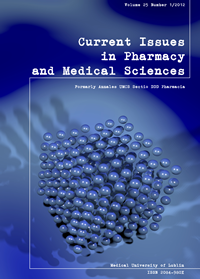Influence of sterilization on the rheological properties of different types polyacrylic acid gels
DOI:
https://doi.org/10.12923/j.2084-980X/25.1/a.17Słowa kluczowe:
rheology, ophthalmic gel, CarbopolAbstrakt
The aim of the study was to analyze the influence of sterilization conditions on the rheological properties of gels containing polyacrylic acid derivatives (Carbopols: 974P, Ultrez 10 and Ultrez 20). The gels utilized in this study contained 0.5% (w/w) metronidazole, antiprotozoal drug (model drug substance). Their rheological properties were determined: flow curve, yield point, apparent viscosity. Moreover, a statistical analysis of factors (polymer type, polymer concentration, sterilization by autoclaving) was undertaken, and their impact on viscosity, yield point and area under flow curve was ascertained. Among this polymers, gels comprising Carbopol 974P were the most stable to sterilization conditions.
Bibliografia
1. Adams I. and Davis S.S.: Formulation and sterilization of an original lubricant gel base in carboxypolymethylene: J. Pharm. Pharmacol., 25, 640, 1973.
2. Bindal A. et al.: Effect of steam sterilization on the rheology of polymer solutions. Pharm. Dev. Technol., 8, 219, 2003.
3. Desai D. D., Hasman D. F. and Schmucker-Castner J.F.: Advance in Carbomer Polymer Technology. BF Goodrich documentation, 1996.
4. Deshpande S. G. and Shirolkar S.: Sustained release ophthalmic formulations of pilocarpine. J. Pharm. Pharmacol., 41, 197, 1989.
5. Ludwig A.: The use of muco-adhesive polymers in ocular drug delivery. Adv. Drug Deliv. Rev., 57, 1595, 2005.
6. Rowe R.C., Sheskey P.J. and. Owen S.C, editors (2005). Handbook of Pharmaceutical Excipients 5th Ed., APhA, London and Chicago.
7. Schaub A. F.: Novel Composition For Easing Human Childbirth. Patent US2008103214, 2008.
8. Zatloukal Z. and Šklubalová Z.: Sterilized Ophthalmic Hydrogels with Hydroxypropyl Methylocellulose: Determination and Mathematical Treatment of Flow Properties. Pharm. Dev. Technol., 12, 55, 2007.
Pobrania
Opublikowane
Numer
Dział
Licencja
Prawa autorskie (c) 2012 Autorzy

Praca jest udostępniana na licencji Creative Commons Attribution-NonCommercial-NoDerivatives 3.0 Unported License.


